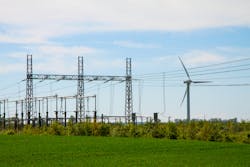ACORE Study: Transmission Expansion Enables Low-Cost Renewable Energy
Following the Midcontinent Independent System Operator’s (MISO) recent approval of 18 new transmission lines, the largest transmission expansion to enable low-cost clean energy in U.S. history, the American Council on Renewable Energy (ACORE) and Grid Strategies are releasing a new analysis identifying best practices for quantifying the benefits of large-scale transmission.
The report explores MISO’s long-range transmission planning process and the methodologies used to evaluate transmission benefits in a case study that offers recommendations on areas that can be improved and replicated by other planning entities and the Federal Energy Regulatory Commission (FERC).
Enabling Low-Cost Clean Energy and Reliable Service Through Better Transmission Benefits Analysis was prepared by Grid Strategies for ACORE on behalf of the Macro Grid Initiative. To download a copy of the report, click here.
“When the benefits of proposed transmission lines are fully calculated, the advantages of new lines are made clear to regional planners,” said ACORE’s President and CEO Gregory Wetstone. “Building off MISO’s forward-leaning process, our analysis offers a roadmap for FERC and other planning entities that, if adopted, will result in a cleaner, lower-cost electric grid. FERC does not yet have standards in place on what transmission benefits to measure and how, resulting in widely varied and imprecise practices nationwide.”
MISO’s stakeholder-informed plan identified about $37.3 billion worth of benefits from the 18 new transmission lines, which the analysis found is a conservative estimate that potentially undercounts billions of dollars in value. The new report benchmarks the benefits MISO assessed with the 12 categories suggested in FERC’s Notice of Proposed Rulemaking on transmission planning.
“MISO pioneered multi-benefit planning and has done it again with this latest portfolio,” said Rob Gramlich, Founder and President of Grid Strategies. “While it is both common-sense and standard economic policy to consider all of the benefits and all of the costs when doing benefit-cost analysis or evaluating public utility investments, it is unfortunately not at all standard at this time in the U.S. transmission sector. With this report we hope to highlight MISO’s good methods, suggest some modest improvements, and encourage similar practices in other planning regions.”
About the Author
T&D World Staff
Content Team
Nikki Chandler
Group Editorial Director, Energy
[email protected]
Jeff Postelwait
Managing Editor
[email protected]
Christina Marsh
Senior Editor
[email protected]
Ryan Baker
Associate Editor
[email protected]
Amy Fischbach
Electric Utility Operations
[email protected]
Rich Maxwell
Community Editor
[email protected]
Gene Wolf
Technical Editor
[email protected]
